高考英语重点语法形容词和副词
- 格式:docx
- 大小:25.82 KB
- 文档页数:12
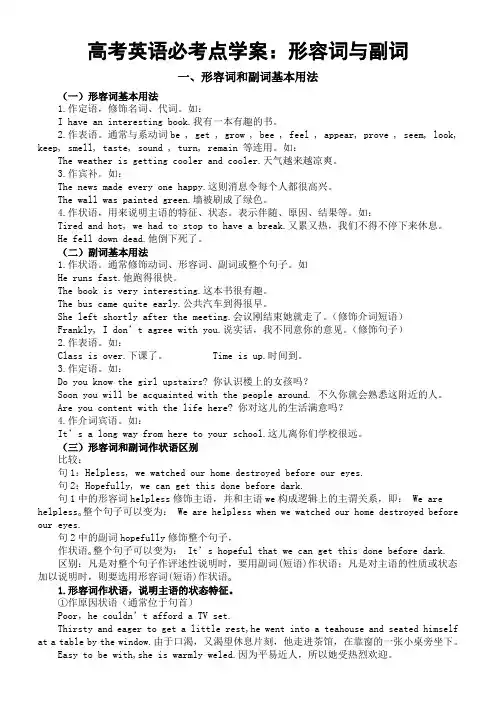
高考英语必考点学案:形容词与副词一、形容词和副词基本用法(一)形容词基本用法1.作定语,修饰名词、代词。
如:I have an interesting book.我有一本有趣的书。
2.作表语。
通常与系动词be , get , grow , bee , feel , appear, prove , seem, look, keep, smell, taste, sound , turn, remain 等连用。
如:The weather is getting cooler and cooler.天气越来越凉爽。
3.作宾补。
如:The news made every one happy.这则消息令每个人都很高兴。
The wall was painted green.墙被刷成了绿色。
4.作状语,用来说明主语的特征、状态。
表示伴随、原因、结果等。
如:Tired and hot, we had to stop to have a break.又累又热,我们不得不停下来休息。
He fell down dead.他倒下死了。
(二)副词基本用法1.作状语。
通常修饰动词、形容词、副词或整个句子。
如He runs fast.他跑得很快。
The book is very interesting.这本书很有趣。
The bus came quite early.公共汽车到得很早。
She left shortly after the meeting.会议刚结束她就走了。
(修饰介词短语)Frankly, I don’t agree with you.说实话,我不同意你的意见。
(修饰句子)2.作表语。
如:Class is over.下课了。
Time is up.时间到。
3.作定语。
如:Do you know the girl upstairs? 你认识楼上的女孩吗?Soon you will be acquainted with the people around. 不久你就会熟悉这附近的人。

高中英语语法复习天津市汉沽区第五中学刘华(一) 形容词、副词的作用与位置1. 形容词是用来修饰名词的,常被放在名词前作定语或放在系动词后面作表语。
He is a young man.He is young.2.副词则用来修饰形容词、动词、其他副词或者句子,一般位于形容词之前,动词之后或句子之首。
It’s very good.He runs fast.I’m very well.He has not been to Japan recently.以下属几种特殊情况,须牢记:1.形容词短语作定语,定语后置。
a language difficult to mastera leaning tower about 180 feet high2. 表语形容词(afraid , alike , alone , asleep, awake , alive 等)作定语,定语后置如a man alive有些表身体健康状况的形容词如well , faint ,ill 只作表语。
sick既可作表语又可作定语,ill 如作定语意为“bad” 。
3. 形容词用作定语,修饰不定代词通常后置。
Something important4. else 常用作疑问代词和不定代词的后置定语。
What else, somebody else.5. enough 修饰名词前置.I have enough money to buy this book .但enough 修饰形容词、副词时必须后置。
He runs fast enough.This book is good enough.6. 几个副词并列作状语时,其顺序较灵活,一般是:方式-地点-时间。
We had a good time together outdoors last Sunday.7. 频度副词often , always , usually 等放在be 之后、行为动词前。
He is always working hard.8. 副词作定语,定语后置。
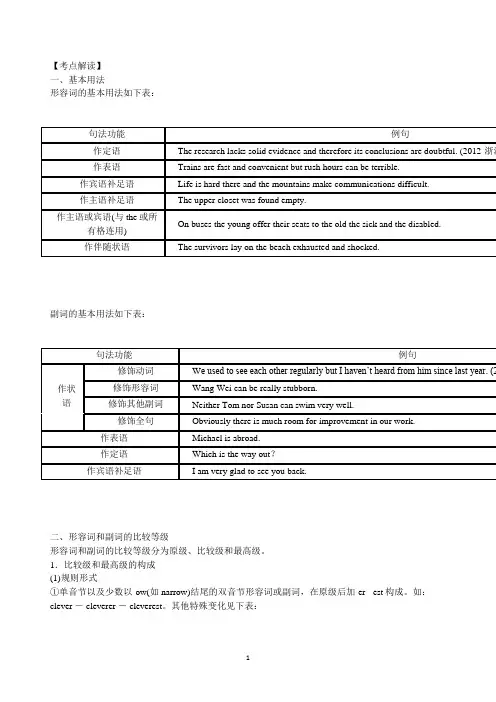
【考点解读】一、基本用法形容词的基本用法如下表:副词的基本用法如下表:二、形容词和副词的比较等级形容词和副词的比较等级分为原级、比较级和最高级。
1.比较级和最高级的构成(1)规则形式①单音节以及少数以-ow(如narrow)结尾的双音节形容词或副词,在原级后加-er -est构成。
如:clever - cleverer - cleverest。
其他特殊变化见下表:②多音节和部分双音节形容词和副词,在原级前加more most构成。
active - more active - most activehappily - more happily - most happily(2)不规则形式good/well - better - bestfar - farther/further - farthest/furthestbad /ill /badly - worse - worstold - older/elder -oldest/eldestmany/much - more - mostlittle - less - least2.基本用法(1)两者相比(甲=乙),用“as+原级+as”表示。
For cheerleaders their sport is just as serious as baxxxxseball or football.【温馨提示】在同等比较级中,若同时出现形容词修饰单数可数名词,其语序为:as+adj.+a+n.+as。
I have never had as boring a day as today.(2)两者相比(甲<乙),用“not as/so+原级+as”表示。
Unfortunately my wife isn’t so fond of them as I am.(3)两者相比(甲>乙),用“比较级+than”表示,(甲<乙)用“less+原级+than”表示。
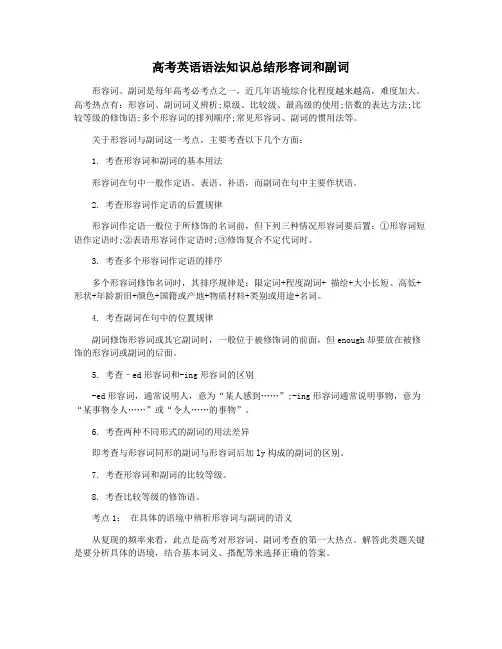
高考英语语法知识总结形容词和副词形容词、副词是每年高考必考点之一,近几年语境综合化程度越来越高,难度加大。
高考热点有:形容词、副词词义辨析;原级、比较级、最高级的使用;倍数的表达方法;比较等级的修饰语;多个形容词的排列顺序;常见形容词、副词的惯用法等。
关于形容词与副词这一考点,主要考查以下几个方面:1. 考查形容词和副词的基本用法形容词在句中一般作定语、表语、补语,而副词在句中主要作状语。
2. 考查形容词作定语的后置规律形容词作定语一般位于所修饰的名词前,但下列三种情况形容词要后置:①形容词短语作定语时;②表语形容词作定语时;③修饰复合不定代词时。
3. 考查多个形容词作定语的排序多个形容词修饰名词时,其排序规律是:限定词+程度副词+ 描绘+大小长短、高低+形状+年龄新旧+颜色+国籍或产地+物质材料+类别或用途+名词。
4. 考查副词在句中的位置规律副词修饰形容词或其它副词时,一般位于被修饰词的前面,但enough却要放在被修饰的形容词或副词的后面。
5. 考查–ed形容词和-ing形容词的区别-ed形容词,通常说明人,意为“某人感到……”;-ing形容词通常说明事物,意为“某事物令人……”或“令人……的事物”。
6. 考查两种不同形式的副词的用法差异即考查与形容词同形的副词与形容词后加ly构成的副词的区别。
7. 考查形容词和副词的比较等级。
8. 考查比较等级的修饰语。
考点1:在具体的语境中辨析形容词与副词的语义从复现的频率来看,此点是高考对形容词、副词考查的第一大热点。
解答此类题关键是要分析具体的语境,结合基本词义、搭配等来选择正确的答案。
经过统计,常见常考的形容词和副词有按频度排列:even; interested;interesting; yet; hardly; just; therefore; though; too; very; common;effective; either; ever; fair; however; less; more; nearly; only;purposefully; rather; still; such; surprised; surprising还有以下形容词和副词应当熟悉和掌握: a good many; a number of; acceptable; accidentally; actively; adequately; already; another; anxious; anyway; ashamed; attentively; bad; badly; besides; better; but; careful; changeable; cheap; comfortable; convenient; eagerly; easy; encouraging; enha-ncing; equal; even though; eventually; fairly; far; fewer;following; formally; friendly; gen-erously; gradually; heavily; historic; hopefully; immediately; inaccessible; individual; inevit-able; initial; instead; invisible; largely; never; next; no;normal; nowadays; obviously; ordin-ary; other; otherwise; patient;plenty of; prac-tical; promoting; proper; quickly; readily; reasonable; remote; seldom; seriously; short; so; stimulating; traditional; unavailable; unav-oidable; unfavorable; unfortunately; usual; va-rious; weak; well考点2:考查形容词、副词的比较级、最高级及前面的修饰语【备考清单】1 比较级、最高级的选用及应用范围比较级、最高级常用于表示两者或多者间的比较。
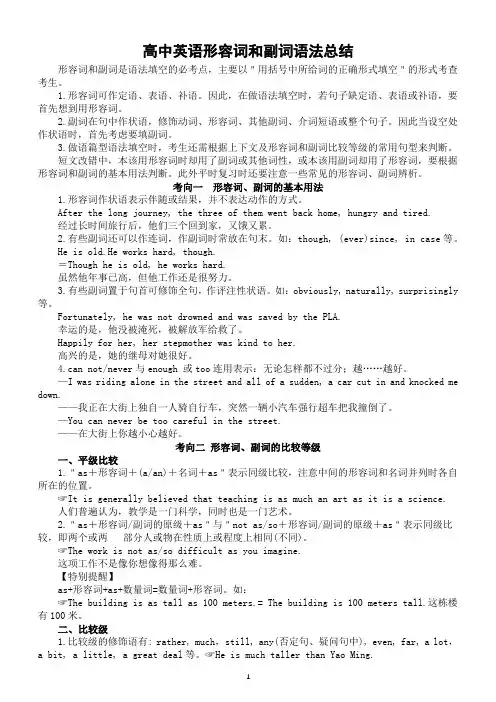
高中英语形容词和副词语法总结形容词和副词是语法填空的必考点,主要以"用括号中所给词的正确形式填空"的形式考查考生。
1.形容词可作定语、表语、补语。
因此,在做语法填空时,若句子缺定语、表语或补语,要首先想到用形容词。
2.副词在句中作状语,修饰动词、形容词、其他副词、介词短语或整个句子。
因此当设空处作状语时,首先考虑要填副词。
3.做语篇型语法填空时,考生还需根据上下文及形容词和副词比较等级的常用句型来判断。
短文改错中,本该用形容词时却用了副词或其他词性,或本该用副词却用了形容词,要根据形容词和副词的基本用法判断。
此外平时复习时还要注意一些常见的形容词、副词辨析。
考向一形容词、副词的基本用法1.形容词作状语表示伴随或结果,并不表达动作的方式。
After the long journey, the three of them went back home, hungry and tired.经过长时间旅行后,他们三个回到家,又饿又累。
2.有些副词还可以作连词,作副词时常放在句末。
如:though, (ever)since, in case等。
He is old.He works hard, though.=Though he is old, he works hard.虽然他年事已高,但他工作还是很努力。
3.有些副词置于句首可修饰全句,作评注性状语。
如:obviously, naturally, surprisingly 等。
Fortunately, he was not drowned and was saved by the PLA.幸运的是,他没被淹死,被解放军给救了。
Happily for her, her stepmother was kind to her.高兴的是,她的继母对她很好。
4.can not/never与enough 或too连用表示:无论怎样都不过分;越……越好。
—I was riding alone in the street and all of a sudden, a car cut in and knocked me down.——我正在大街上独自一人骑自行车,突然一辆小汽车强行超车把我撞倒了。
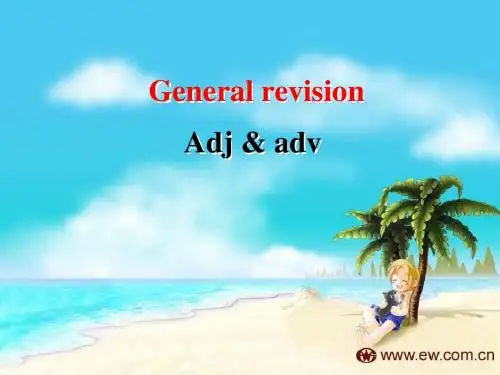
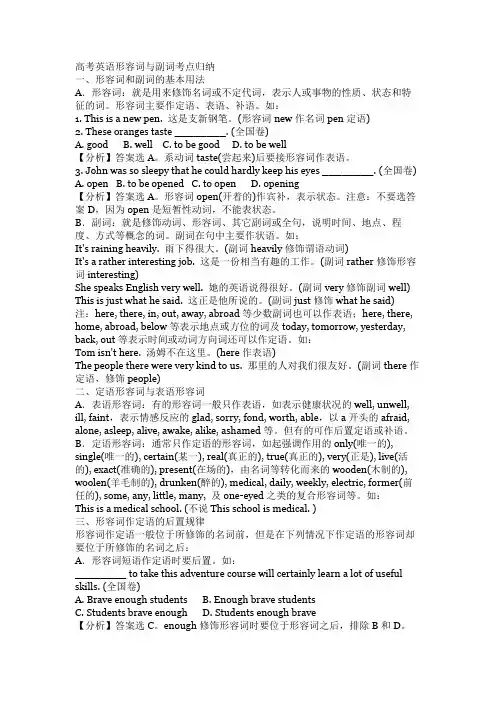
高考英语形容词与副词考点归纳一、形容词和副词的基本用法A.形容词:就是用来修饰名词或不定代词,表示人或事物的性质、状态和特征的词。
形容词主要作定语、表语、补语。
如:1. This is a new pen. 这是支新钢笔。
(形容词new作名词pen定语)2. These oranges taste ________. (全国卷)A. goodB. wellC. to be goodD. to be well【分析】答案选A。
系动词taste(尝起来)后要接形容词作表语。
3. John was so sleepy that he could hardly keep his eyes ________. (全国卷)A. openB. to be openedC. to openD. opening【分析】答案选A。
形容词open(开着的)作宾补,表示状态。
注意:不要选答案D,因为open是短暂性动词,不能表状态。
B.副词:就是修饰动词、形容词、其它副词或全句,说明时间、地点、程度、方式等概念的词。
副词在句中主要作状语。
如:It's raining heavily. 雨下得很大。
(副词heavily修饰谓语动词)It's a rather interesting job. 这是一份相当有趣的工作。
(副词rather修饰形容词interesting)She speaks English very well. 她的英语说得很好。
(副词very修饰副词well) This is just what he said. 这正是他所说的。
(副词just修饰what he said)注:here, there, in, out, away, abroad等少数副词也可以作表语;here, there, home, abroad, below等表示地点或方位的词及today, tomorrow, yesterday, back, out等表示时间或动词方向词还可以作定语。
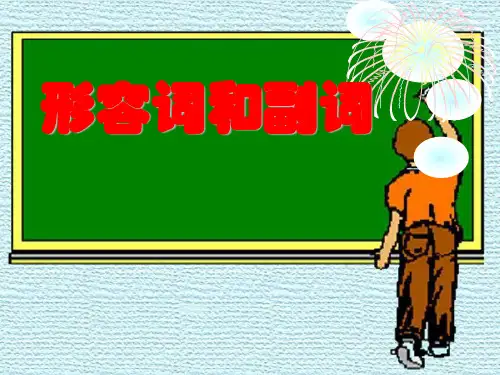
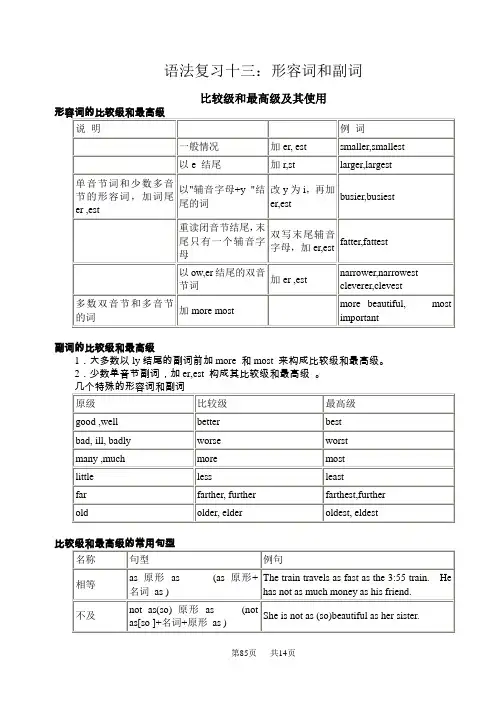
语法复习十三:形容词和副词比较级和最高级及其使用副词的比较级和最高级1.大多数以ly结尾的副词前加more 和most 来构成比较级和最高级。
2.少数单音节副词,加er,est 构成其比较级和最高级。
比较级结构的修饰语1.用于原级之前:a l m o s t,n e a r l y,j u s t, e x a c t l y,q u i t e,h a l f, t w i c e,t h r e et i m e s,at h i r d,e t c.J o h n i sa l m o s t a st a l l a s y o u.T h er i v e r i st h r e e t i m e sa s l o n g a st h a t o n e.W e h a v e a t h i r d a s m a n y s t u d e n t s a sw e h a d l a s tt e r m.2.用于比较级前m a n y,af e w(用于"m o r e+可数名词"前)I t t a k e sm a n y m o r eh o u r s t o g ot h e r e b yt r a i n t h a n b yp l a n e.a l o t,m u c h,a b i t,e v e n,al i t t l e,s t i l l,ag r e a t d e a l,f a r,r a t h e r,t w o y e a r s,t e np e r c e n t,t h r ee t i m e s e t c.I t'sc o ld t h i sy e a r,b u ti t's e v e nc o lde r l a s ty e a r.W ep r o d u c e d6%m o r e g r a i nt h i s y e a rt h a n w e d i dl a s t y e a r.3.用于形容词和最高级前t h e v e r y, m u c h t h e,b yf a r t h e,t h ef i r s t/s e c o n dT h i s h a ti s b y f a r t h el a r g e s t i nt h e w o r l d.G o l d i st h e v e r y m o s tv a l u a b l e o fa l lm a t e r i a l s.位置与功能高考重点要求1.掌握形容词、副词比较级、最高级的常用句型及用法2.掌握形容词、副词的原级、比较级和最高级修饰语及倍数的比较表达。
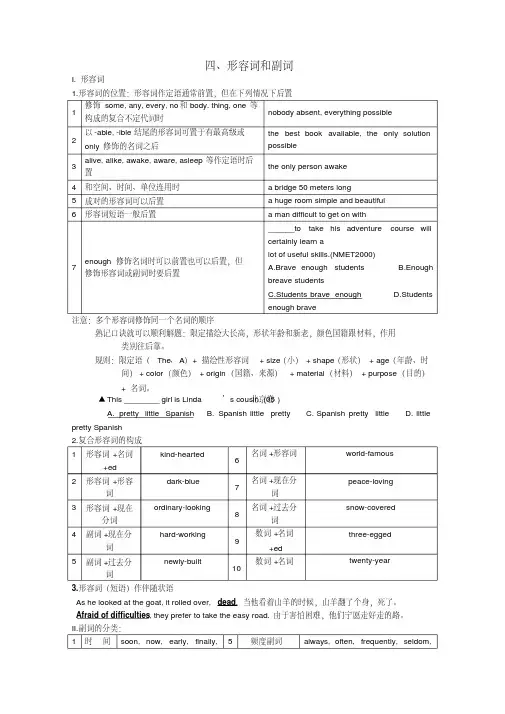

高考英语形容词和副词形容词(Adjectives)和副词(Adverbs)是英语语法中非常重要的词类,在高考英语考试中占据着重要地位。
本文将从形容词和副词的定义、用法以及相关练习等方面进行论述。
一、形容词的定义和用法形容词是一种用来修饰名词或代词的词类。
它可以描述事物的性质、特征或状态,使句子更加详细和丰富。
形容词通常出现在名词前面,用来修饰它所在的名词,起补充说明的作用。
1.1 形容词的定义形容词是一类可以修饰名词或代词的词,以描述人、事、物的性质、特征和状态。
1.2 形容词的用法形容词可以通过以下几种方式使用:(1)作为定语修饰名词:a beautiful girl(一个漂亮的女孩)(2)作为表语:The weather is sunny.(天气晴朗)(3)作为宾补:I found the book interesting.(我觉得这本书有趣)二、副词的定义和用法副词是一种修饰动词、形容词、副词等的词类,用来说明行为或状态的方式、程度、频率、原因等。
副词可以增加句子的信息量,使句子更加准确和精确。
2.1 副词的定义副词是一类修饰动词、形容词或其他副词的词,用以表达行为或状态的方式、程度或其他相关信息。
2.2 副词的用法副词可以通过以下几种方式使用:(1)修饰动词:He runs quickly.(他跑得快)(2)修饰形容词:She is extremely beautiful.(她非常漂亮)(3)修饰副词:He reads very carefully.(他读书很认真)三、形容词和副词的比较级和最高级形容词和副词在表示比较程度时,可使用比较级和最高级。
比较级用于两者之间进行比较,最高级用于多者之中的极端比较。
3.1 形容词和副词的比较级和最高级形式(1)一般情况下,添加-er表示比较级,添加-est表示最高级。
如:fast → faster → fastest(2)以不发音的e结尾的词,直接加-r表示比较级,加-st表示最高级。
高考英语语法复习
形容词与副词知识讲解
一、形容词的用法
被形容词修饰的名词若还有其他词修饰,如冠词、指示代词、形容词性物主代词等,这些词要置于形容词前。
名词前的多个修饰语可用
“限定描绘大长高,
形状年龄和新老,
颜色国籍出材料,
作用类别往后靠”
来记忆。
二、易用错的几类形容词
三、形容词的比较等级
English is as interesting a subject as Chinese.
Which is the better of the two watches?
She is the taller of the two girls.
other或else把主语排除在比较对象之外;但如果不在同一范围比较则不需要用。
Susan is taller than any girl in her sister’s class.
四、副词的句法功能
五、副词的位置
六、副词比较等级的用法。
高考英语形容词与副词一、形容词01 形容词的句法功能02 形容词的位置形容词作定语时一般置于被修饰词前作前置定语,下列情况中形容词通常后置于被修饰词。
(1)修饰something,anybody,nobody,anything等复合不定代词时There is nothing wrong with the machine.(机器什么问题都没有。
)(2)形容词词组作定语时She bought a book suitable for children.(她买了本适合孩子们的图书。
)(3)修饰表示数量的词要后置The baby is only five months old.(这个婴儿仅有五个月大。
)(4)enough作形容词修饰名词时,一般放在名词之前,也可放在名词之后We don't bring enough money.(我们没带够钱。
)There‘ll be time enough to relax when you’ve finished your work.(你完成工作后会有足够的时间来放松。
)[注]形容词常见于定语位置和表语位置,以上只列出几种常见情况讲解。
具体位置要视具体形容词及句子而定。
03 多个形容词修饰名词时的语序按以下顺序排列:(1)限定词(a/an,the,this,his,first,one...)(2)表示特征或性质等描述性形容词(good,pretty...)(3)表示大小、长短、高低的形容词(big,long,little...)(4)表示形状的形容词(round,square...)(5)表示年龄、新旧的形容词(old,young,new...)(6)表示颜色的形容词(red,yellow...)(7)表示国籍、地区、出处的形容词(America,southern,Italian...)(8)表示物质材料的形容词(wooden,woollen,glass...)(9)表示用途、类别的形容词(medical,writing...)a beautiful large green Chinese carpet一块漂亮宽大的绿色的中国地毯the first three days 头三天enormous black iron gates 巨大的黑色铁门04 形容词的特殊用法二、副词01 副词的种类根据词义可分为:(1)时间副词yesterday(昨天),today(今天),now(现在)等。
高考英语语法之形容词和副词第一部分考点精讲精练第1讲比较级考点1.可以修饰比较级的词常用来修饰比较级的词或短语有:a bit, a little, rather, much, far, by far, many, a lot, a great deal, any, still, even等。
by far的用法:用于强调,意为―……得多‖ ―最最……‖ ―显然‖等,可修饰形容词或副词的比较级和最高级,通常置于其后,但是若比较级或最高级前有冠词,则可置于其前或其后。
如:It’s quicke r by far to go by train. 乘火车要快得多。
She ran fastest by far. 她跑得最快(显然她跑得最快)。
He’s by far the cleverer student.他是个聪明得多的孩子。
He is by far the best teacher.=He is the best teacher by far.他是最最好的老师(或他显然是最好的老师)。
1.You are such a woman as always think ____ ofyourself than others.A. muchB. much moreC. littleD. much less2.【2004福建】The number of people present at theconcert was _____than expected. There were many ticket left.A. much smallerB. much moreC. much largerD. many more3.-The novel is, I have to say, not a bit interesting,How do you find it?-Why! It’s ____________ that I have ever read.A. a most interestingB. a more interestedC. a less interestingD. by far the most interesting4.【2007 全国II】After two years’ research, we no whave a ____ better understanding of the disease.A. veryB. farC. fairlyD. quite5.------ The disease he suffers is not easy to cure.------ I know, but is he _____ better?A. muchB. ratherC. anyD. little6.【2000上海】You're standing too near the camera.Can you move ______ ?A. a bit farB. a little fartherC. a bit of fartherD. a little far7.【2006江苏】I wish you’d do ________ talking andsome more work. Thus things will become better.A. a bit lessB. any lessC. much moreD. a little more考点2.more 、much与比较级more 和多音节形容词和副词一起构成比较级,如more interesting, more exciting单音节词和部分双音节词在后面加-er构成比较级.如:taller, earlier, hottermuch修饰比较级。
形容词和副词形容词可用于作表语、定语、宾语补足语、状语等;副词也可以作表语、定语、宾语补足语、状语等。
一、形容词作定语时的位置大部分形容词作定语时放在所修饰的名词前面, 如a red bus, a beautiful park, cold weather等,但实际运用时须注意以下情况。
1.当多个的形容词修饰一个名词时应该注意形容词的一般排列顺序。
“限定词+一般描绘性形容词+表示大小、长短、高低的形容词+表示形状的形容词+表示年龄、新旧的形容词+表示颜色的形容词+表示国籍、地区、出处的形容词+表示物质、材料的形容词+表示用途、类别的形容词+被修饰的名词”例如:his beautiful small round old brown French wooden writing table当然,在实际运用中用如此多的形容词修饰一个名词并不多见。
2.形容词修饰everything, something, anything, nothing时, 只能放在其后面。
如:Some farmers saw something strange in the sky.I’ve got something important to say.There is nothing interesting at all.3.else只能修饰疑问代词who, whom, whose, what和不定代词something, anything, nothing, somebody,someone, anybody, anyone和nobody, no one.而且只能放在其后。
如:Is there anything else you want to say?What else do you want?else与上述疑问代词和不定代词构成所有格时, 只能在else后加's, 而不能在疑问代词或不定代词后加's. 如说someone else's, 而不能说* someone’s else。
专题04形容词和副词知识精讲一、形容词和副词的基本用法(一)形容词在句中的作用1.形容词在句中可作定语、表语和补语①形容词作定语时的位置问题:通常放置被修饰的名词前,但是下列情况需后置:▲形容词短语作定语This is a language difficult to master.这是一门难以掌握的语言。
In the distance there is a leaning tower about 180 feet high.远处有一座180英尺的斜塔。
He is a student worth of praise.他是个值得表扬的学生。
▲表语形容词(参考下列3)作定语He is indeed a Lei Feng alive.他真是个活雷锋。
▲形容词修饰不定代词Someone strange is asking to see you.有个陌生人要见你。
Something unexpected happened and we had to make some changes to our plan.发生了一些意想不到的事情,我们不得不对我们的计划做些改变。
▲else修饰疑问代词和不定代词No one else can answer the question.其他没有人能回答这个问题。
What else do you want to say? 你想还说点什么?②多个形容词作定语时的词序为:大小、长短、高低形状/年龄、新旧颜色/来源、国籍、地区、出处/材料/用途(熟记下列顺口溜:限定描绘大长高,形状年龄和新老,颜色国籍跟材料,作用类别往后靠)。
It’s a _______ clock, made of brass and dating from the nineteenth century.A. charming French smallB. French small charmingC. small French charmingD. charming small French【答案与解析】D。
2017高考英语重点语法:高考英语常考语法总结——形容词和副词形容词、副词是每年高考必考点之一,近几年语境综合化程度越来越高,难度加大。
高考热点有:形容词、副词词义辨析;原级、比较级、最高级的使用;倍数的表达方法;比较等级的修饰语;多个形容词的排列顺序;常见形容词、副词的惯用法等。
关于形容词与副词这一考点,主要考查以下几个方面:1. 考查形容词和副词的基本用法形容词在句中一般作定语、表语、补语,而副词在句中主要作状语。
2. 考查形容词作定语的后置规律形容词作定语一般位于所修饰的名词前,但下列三种情况形容词要后置:①形容词短语作定语时;②表语形容词作定语时;③修饰复合不定代词时。
3. 考查多个形容词作定语的排序多个形容词修饰名词时,其排序规律是:(限定词+程度副词+) 描绘+大小(长短、高低)+形状+年龄(新旧)+颜色+国籍或产地+物质材料+类别或用途+名词。
4. 考查副词在句中的位置规律副词修饰形容词或其它副词时,一般位于被修饰词的前面,但enough却要放在被修饰的形容词或副词的后面。
5. 考查–ed形容词和-ing形容词的区别-ed形容词,通常说明人,意为“(某人)感到……”;-ing形容词通常说明事物,意为“(某事物)令人……”或“令人……的(事物)”。
6. 考查两种不同形式的副词的用法差异即考查与形容词同形的副词与形容词后加ly构成的副词的区别。
7. 考查形容词和副词的比较等级。
8. 考查比较等级的修饰语。
考点1:在具体的语境中辨析形容词与副词的语义从复现的频率来看,此点是高考对形容词、副词考查的第一大热点。
解答此类题关键是要分析具体的语境,结合基本词义、搭配等来选择正确的答案。
经过统计,常见常考的形容词和副词有(按频度排列):even; interested; interesting; yet; hardly; just; therefore; though; too; very; common; effective; either; ever; fair; however; less; more; nearly; only; purposefully; rather; still; such; surprised; surprising还有以下形容词和副词应当熟悉和掌握:a good many; a number of; acceptable; accidentally; actively; adequately; already; another; anxious; anyway; ashamed; attentiv ely; bad; badly; besides; better; but; careful; changeable; cheap; comfortable; convenient; eagerly; easy; encouraging; enha-ncing; equal; even though; eventually; fairly; far; fewer; following; formally; friendly; gen-erously; gradually; heavily; historic; hopefully; immediately; inaccessible; individual; inevit-able; initial; instead; invisible; largely; never; next; no; normal; nowadays; obviously; ordin-ary; other; otherwise; patient; plenty of; prac-tical; promoting; proper; quickly; readily; reasonable; remote; seldom; seriously; shor t; so; stimulating; traditional; unavailable; unav-oidable; unfavorable; unfortunately; usual; va-rious; weak; well考点2:考查形容词、副词的比较级、最高级及前面的修饰语【备考清单】1) 比较级、最高级的选用及应用范围比较级、最高级常用于表示两者或多者间的比较。
复习中须注意如下句型的用法:① as + 原级adj. / adv. + as表示“和……一样”及not as / so + 原级adj. / adv. + as表示“不如……”。
例如:(94全国) John plays football as well as, if not better than, David.The piano in the other shop will be cheaper, but not as good.② as + 原级adj. + a(n) + n. + as表示“跟……一样”。
例如:(2001全国) It’s generally believed that teaching is as much an art as it is a science.(2003北京) Our neighbour has as big a house as ours.③比较级 + than表“比……更”及less ... than表示“不如……”。
例如:This year they have produced less grain than they did last year.This road is wider than that one.④ the + 比较级, the + 比较级表示“越……,就越……”。
例如:(93上海) It’s believed that the harder you work, the better res ult you’ll get.⑤ the +比较级+ of the + 名词 / 代词表示两者中“较……的”。
例如:Who is the younger of the two boys?⑥比较级 + 比较级(越来越……)。
___ 例如:Our country is getting stronger and stronger.Things became worse and worse from then on.⑦用the last表示“最不可能的”、“最不适合的”、“最不希望的”等。
例如:T he last thing I want to do is to offend you.我最不愿意做的就是惹你生气。
He is the last man I want to see.他是我最不希望见的人。
2) 形容词、副词原级、比较级、最高级前的程度状语①注意一些形容词或副词前的特定修饰语。
例如:(2004广东) Sometimes it was a bit boring to work the re because there wasn’t always that much to do. (那样多)I quite like it. They are quite different / wrong.quite possible / impossibleMy hometown is much changed.much to my surprise(很让我吃惊)be well worth doing (很值得做)②比较级前常可用still, even, much, far, a lot / little / few / bit, rather, any, a great deal, so far, by far, no等词修饰。
(注意more不用于修饰比较级)。
例如:(94全国) If there were no examinations, we should have a much happier time.(2000上海) You’r e standing too near the cinema. Can you move a bit farther?This is by far the better.③最高级可用序数词、much、 by far、 nearly、 almost等词修饰。
例如:Afri ca is the second largest continent.The Pacific is by far the largest ocean.I like this film the very best / much the best.考点3:形容词作表语,形容词、副词作后置定语【备考清单】1) 形容词用于系动词后作表语在最近几年高考试题中系动词加形容词作表语的情况出现过很多次。
高考对此点的考查集中于区别到底是系动词还是一般动词并选择合适的形容词,而不是副词作表语。
常见的联系动词有如下三类:表示感觉的系动词:sound, look, taste, appear, smell, feel, seem等表示变化的系动词:become, fall, get, turn, grow, make, come, go等表示状态存在的系动词:remain, keep, stay, continue, prove, lie, stand等。
2) 形容词、副词作后置定语【备考清单】常见的几种修饰语后置的情况有:①形容词修饰something, nothing, anything, everything等不定代词时要后置。
②present作“出席的”时只作后置定语。
③表语形容词如alive, asleep, awake, alone等只能作后置定语。
④副词修饰动词时, 放在动词之后。
修饰形容词或副词时, 放在被修饰词之前。
enough修饰形容词、副词时要后置,修饰名词时可放在名词的前后。
形容词短语修饰名词作主语时要后置。
用and或or连接的形容词作定语时要后置, 起强调作用。
表数量的词作定语时要后置。
副词修饰形容词的特殊词序, “so, as, how, too + 形容词 + 单数可数名词”。
考点4:倍数表达法【备考清单】三种常见倍数表达法:1) 倍数 + as + 原级形容词 + a s ...。
例如:This road is three times as long as that one.2) 倍数 + the size / length / width / depth / height of ...。
例如:The river is five times the width of that one.3) 倍数 + 比较级 + than + 被比较对象。